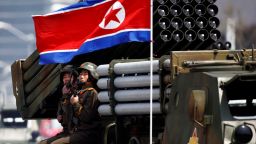Russian military officials have discussed how and under what conditions Russia would use a tactical nuclear weapon on the battlefield in Ukraine, according to a US intelligence assessment described to CNN by multiple sources who have read it.
The assessment, drafted by the National Intelligence Council, is not a high confidence product and is not raw intelligence but rather analysis, multiple people who have read it told CNN. For that reason, some officials believe the conversations reflected in the document may have been taken out of context, and do not necessarily indicate that Russia is preparing to use a nuclear weapon.
The US has still not seen any signs that Russian President Vladimir Putin has decided to take the drastic step of using one, officials said, and Putin is not believed to have been involved in the discussions described in the NIC product.
But others within the administration who have viewed the document have reacted with concern, because it provides a rare window into conversations between senior Russian generals and reveals their intensifying frustration about Russia’s losses on the battlefield in Ukraine. That frustration could turn into desperation, some officials fear. There are also questions about whether Russia’s self-declared annexation of eastern Ukraine earlier this year means Russia is willing to take more extreme measures to protect that territory.
The US has also been watching Russia’s actions around the southern Ukrainian city of Kherson, which Ukrainian forces are trying to take back from Russian forces in a counteroffensive. In recent weeks, Russian officials have ordered the city to be evacuated, and the US is concerned that if Ukraine drives the Russians out in a humiliating defeat, it could be the kind of trigger that would lead Putin to resort to tactical nukes. It’s among the scenarios envisioned by the intelligence assessment, although officials emphasized that Kherson is not the sole focus of the product.
The New York Times first reported on the intelligence assessment. But the internal divisions over the quality of the intelligence and how to interpret it has not been previously reported.
Tactical nuclear weapons are sometimes described as “small nukes,” because they are typically smaller nuclear warheads that are intended for use in a limited strike on a battlefield. They have explosive yields of 10 to 100 kilotons of dynamite, whereas “strategic” nuclear weapons have explosive yields of 500 to 800 kilotons and are designed to destroy entire cities. But tactical nuclear weapons can still be unimaginably deadly: the bombs dropped on Hiroshima and Nagasaki in Japan in 1945 were the equivalent of about 15 to 21 kilotons, respectively.
CNN has previously reported that US officials believe that the likelihood Putin will use a tactical nuclear weapon in Ukraine is perhaps the highest it has been since Russia invaded in February – but is still not probable.
Any use of nuclear weapons would generate international outrage and would put pressure on the US and NATO to take retaliatory action.
“I don’t have any comment on the particulars of this reporting,” National Security Council official John Kirby said in a statement. “We’ve been clear from the outset that Russia’s comments about the potential use of nuclear weapons are deeply concerning, and we take them seriously. We continue to monitor this as best we can, and we see no indications that Russia is making preparations for such use.”
Russia’s Defense Ministry on Wednesday wrote in a statement on its website that its nuclear doctrine will only permit the use of atomic weapons in a way that is defensive in nature and that the strict guidelines “pursue solely defensive goals.” It added that Russia would only “hypothetically resort to nuclear weapons exclusively in response to an aggression involving the use of weapons of mass destruction or an aggression with the use of conventional weapons when the very existence of the state is in jeopardy.”
The assessment is not a raw intelligence product and the sourcing for it is not robust, sources told CNN. But the internal jockeying over how to interpret the assessment reflects the broader difficulty the US has had in confidently determining whether Putin would actually go as far as using a nuclear weapon in Ukraine. Only Putin can know what is in his own head, officials have emphasized.
Concerns escalated after Putin warned in a speech in September that “In the event of a threat to the territorial integrity of our country and to defend Russia and our people, we will certainly make use of all weapon systems available to us. This is not a bluff.”
And last week, Russian officials began alleging that Ukraine was preparing to use a “dirty bomb“– an allegation the US worried was simply a pretext for Russia to use one itself.
“The reason this particular allegation gives us some concern is because Russia has a track record of projecting, which is to say, accusing others of doing something that they themselves have done or are thinking about doing,” Secretary of State Antony Blinken said at a Bloomberg event last week. Blinken noted that the US had “communicated directly and very clearly to the Russians, President Putin about the consequences” if he does use a nuclear weapon.
CNN’s Barbara Starr contributed reporting.








